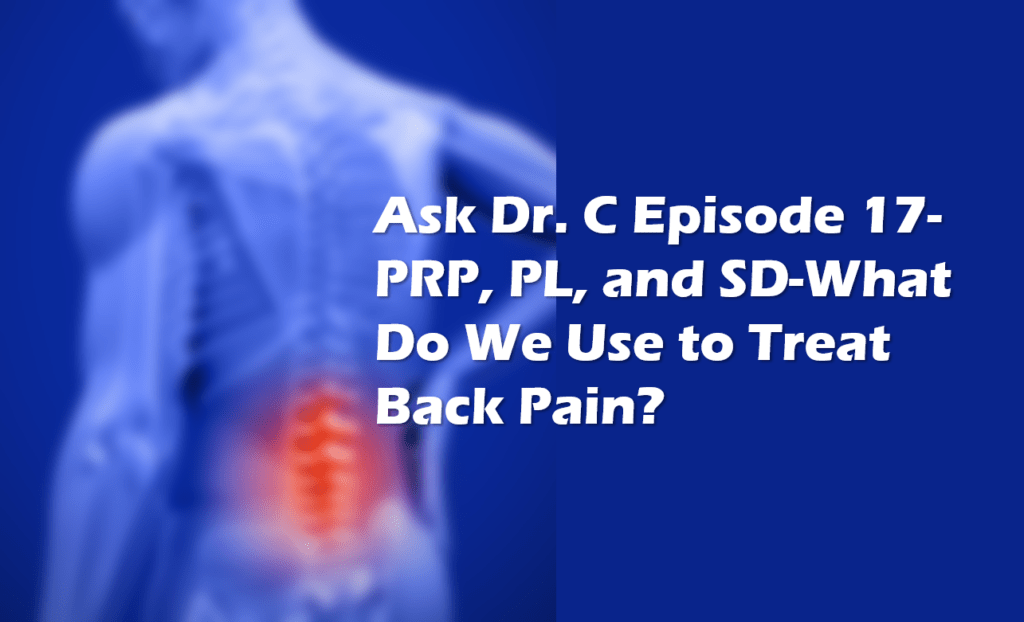Ask Dr. C Episode 17-Low Back Pain and Platelets/Stem Cells

Looks like I got a bunch of great questions over the holidays. Some I will answer in the comments, but the ones that seem to apply to the common issues of many people, I’ll write a blog about. Today’s entry comes from Joe who has questions about low back pain, platelets, and stem cells.
This was Joe’s question: When it comes to lower lumbar pain management (L3-S1) including the ligaments, facets, multifidus and epidural canal, are concentrated (16x+) Lysate/PRP injections just as beneficial as stem cells? Explain the differences.
Lastly, for a Regenexx SD stem cell procedure what are the maximum number of cores you can extract and process from the pelvic bone (iliac crest)? Are more cores better to increase cell count? Elaborate if applicable.
First Joe is curious if platelet lysate, PRP, and stem cells are the same thing or different things when used to treat various parts of the low back that could be injured. The answer is that they are all different things that act a bit or very differently and have uses in different spine pathologies. Let’s dig in.
PRP is platelet-rich plasma. That means that the clinic takes blood and isolates and concentrates the platelets and then uses that product for the injection. PRP can come in two main flavors-leukocyte rich (LR) and leukocyte poor (LP). LR-PRP is red because the white and red blood cells are also isolated with the platelets. LP-PRP is amber because there are far fewer red and white blood cells isolated with the platelets. For patients with low back pain, high dose LP-PRP (14X) is often used to treat facet joint pain or arthritis through fluoroscopically guided injection. 14X means that the platelets are concentrated 14 times higher than they would naturally occur in the blood. Using the same fluoroscopy technology to guide the needle, 20X LR-PRP is used to treat disc pain.
Platelet lysate (PL) is made from PRP. Here, various technologies can be used to break the platelets open and release the growth factors into the plasma. Since that’s how platelets help repair tissues, platelet lysate has more growth factors available right away for use to help with healing. PRP, which still has whole platelets releases those same growth factors over time. So PL is like an immediate release pill whereas PRP is like a sustained release pill. We use PL for two things. We use an anti-inflammatory version around spinal nerves (epidural) and a pro-inflammatory version to inject into ligaments to tighten those down and treat degenerative instability.
A stem cell injection (SD) is sourced from the bone marrow. Here, two different fractions of the bone marrow are isolated, with each being rich in stem cells. This is also called BMC (Bone Marrow Concentrate). Stem cells can both recruit other cells to repair tissue as well as turn into (differentiate) into needed cells. They also have many other proposed mechanisms of action. We use BMC in the spine for more severely injured low back discs or when platelet based therapies don’t work well (about 10% of all patients we see with low back issues).
Joe’s second question is about a bone marrow aspiration (BMA). This is when the doctor uses a specialized needle (trocar) to extract bone marrow aspirate (looks like thick blood) from the back of the pelvis. He’s asking about “cores” but that’s actually a different procedure called a bone marrow biopsy where instead of the liquid aspirate obtained in a BMA, the doctor tries to take a piece of the structural bone.
For a BMA (not a biopsy), the more sites that the doctor takes small samples from (typically a maximum of 5cc), the greater the number of stem cells. Why? The bone marrow space communicates with the peripheral blood circulation, so if you take more volume per site, you just end with blood that contains few stem cells rather than bone marrow aspirate which is rich in stem cells. For the average low back pain patient where we’re using stem cells, we would draw about 90 cc total between the right and the left. This means that 9 different sites on each side would be accessed, usually through the same skin site. Some of those would be different locations on the pelvis and some of those would be at different depths.
The upshot? As you can see, these platelet and stem cell technologies we use to treat low back pain are all different. I hope I was able to answer all of the aspects of Joe’s great question!

If you have questions or comments about this blog post, please email us at [email protected]
NOTE: This blog post provides general information to help the reader better understand regenerative medicine, musculoskeletal health, and related subjects. All content provided in this blog, website, or any linked materials, including text, graphics, images, patient profiles, outcomes, and information, are not intended and should not be considered or used as a substitute for medical advice, diagnosis, or treatment. Please always consult with a professional and certified healthcare provider to discuss if a treatment is right for you.
